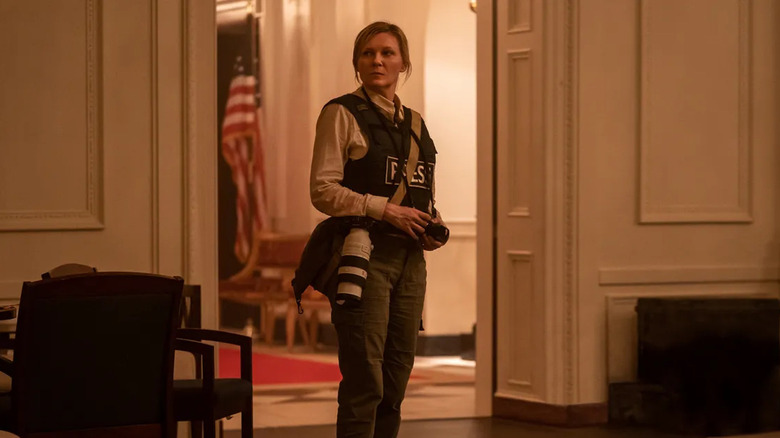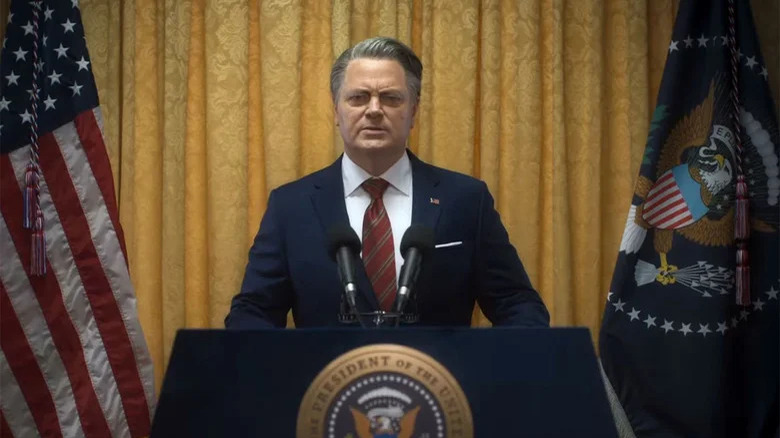How The Shocking Ending Of Civil War Was Created
Major spoilers for "Civil War" follow.
Alex Garland's "Civil War" is on our list of one of the best movies of the year, and while some folks seem rather cold on the film, I think it's pretty damn good (you can read our positive review of the film right here). One of the things that fully sold me is the big, harrowing, action-packed climax. In "Civil War," a new American civil war has torn the country apart. The story picks up in the final days of the war, following a group of journalists as they drive across the war-scarred country, encountering various horrors along the way. In the film's third and final act, the journalists find themselves embedded with secessionist forces, known as the Western Forces, or WF.
One of the biggest complaints about "Civil War" is that Garland's script remains almost maddeningly neutral in regards to the conflict. In fact, we don't even learn much about the conflict itself at all. This is all by design — the film is neutral because its main characters are neutral. They're journalists who deliberately don't want to pick sides; they just want to get the story. That said, Garland sprinkles in some details here and there that make it somewhat clear what's going. While the WF are secessionists and could be seen as "bad guys," some dialogue makes it pretty obvious that the unnamed President of the United States, played by Nick Offerman, is a full-blown fascist, perhaps even a dictator. We learn that he's now serving his third term as president, he's dismantled the FBI (which, to be fair, isn't such a bad thing, now, is it?), and he's ordered drone strikes on American civilians. And while Garland has gone on record saying Offerman's character is not based directly on wannabe dictator Donald Trump, the character sports a red necktie in his final scenes, which is kind of a Trump trademark at this point. Feel free to draw your own conclusions, that's all I'm saying.
In the film's shocking finale, the WF invades Washington D.C., a moment that first features heavy firefighting on the streets of the nation's capital and then moves into the White House itself. As you might guess, this was a tricky sequence to pull off.
Building Washington D.C. for Civil War
"Civil War" is now on 4K UHD, Blu-ray, DVD, and Digital, and the physical disc release features a six-part documentary titled "Torn Asunder: Waging Alex Garland's Civil War." In the last part of the documentary, the cast and crew talks about staging the film's final battle. Garland first mentions that the movie is following the blueprint of "Apocalypse Now," in that it's a series of increasingly intense set-pieces, leading to one grand finale. The "Civil War" finale sees soldiers on the streets of D.C., shooting at each other among highly recognizable landmarks.
Since the filmmakers couldn't shoot in Washington D.C. itself, they built a version of Washington D.C. in a parking lot in Atlanta, and extended the sets digitally. About 50 stunt people were used for the scene — the production would simply move them around to different spots to make the number look even bigger. Three different White House sets were also used — there was a large exterior set in Atlanta, which was built about 75% to scale. Then there was an interior set used for the hallways of the building. And finally, there was a digital White House as well.
Speaking with Art of VFX, VFX supervisor David Simpson elaborated further. "A few months before shooting, we flew to Washington DC," Simpson said. "We went out one night and walked from the Lincoln Memorial to the White House — taking lots of photographs and discussing sequences, staging, troop movements. From there, we travelled back to Atlanta and locations began scouting for places that could play as D.C. Atlanta has a lot of incredible locations, don't get me wrong, but we couldn't find anything that worked for Washington D.C."
Simpson adds that they "came close" to shooting in one on-location spot on the streets of Atlanta. However, with all the gunfire, explosions, and action involved with the scene, "it would have been a nightmare. In order to get permission to shoot there would have required lots of creative compromises." So instead, the crew "moved to a parking lot at Stone Mountain.We had three partial builds in the Yellow Daisy Parking lot: The Lincoln Memorial, 17th Street and Pennsylvania Avenue."
The results speak for themselves: the finale is wholly believable. It looks like the action is really taking place in the real D.C., and the real White House, and that only makes the moment more powerful (and disturbing).

